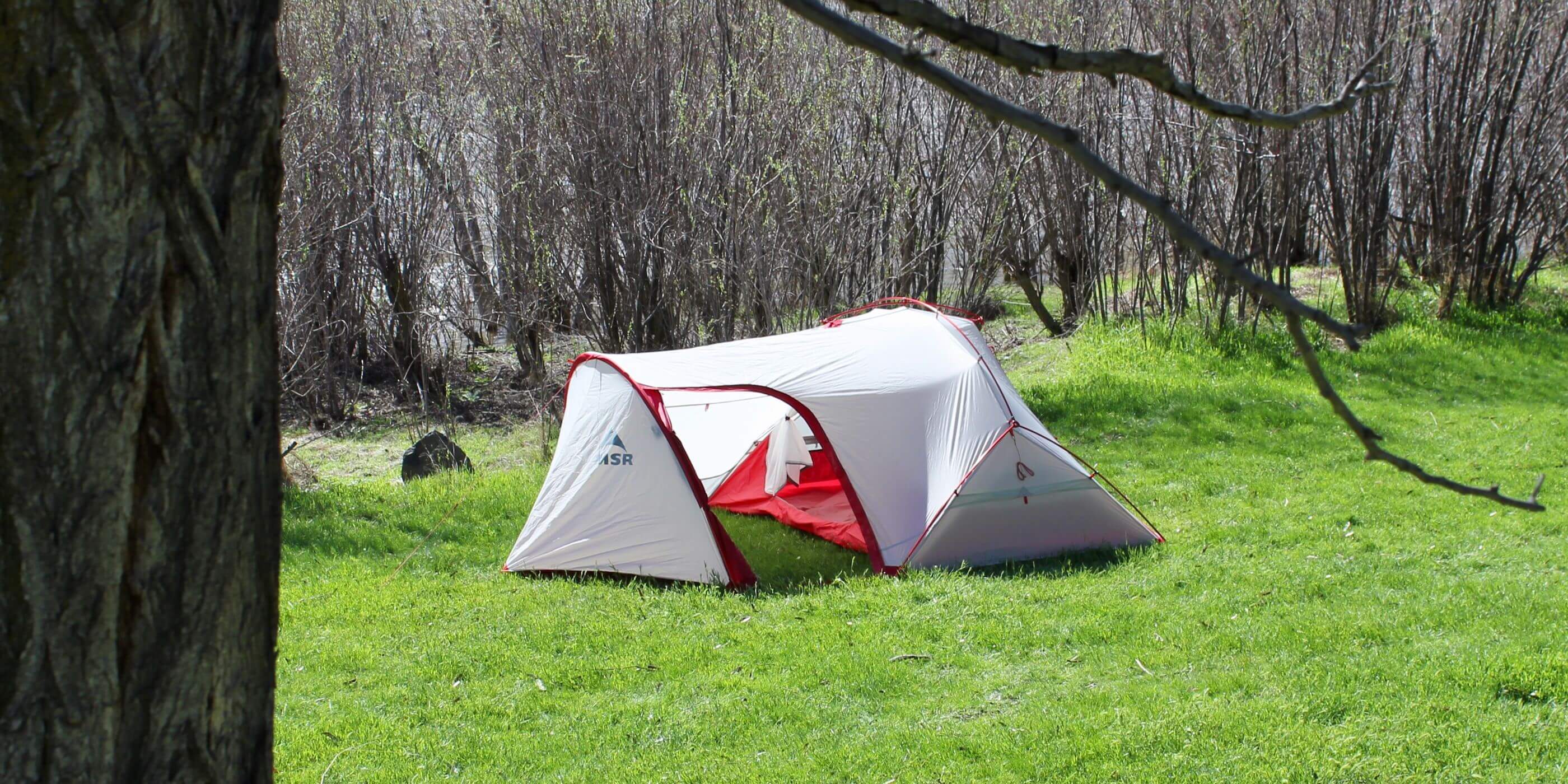The new MSR Hubba Tour 2 is a lightweight tent designed for longer-term adventure touring — think epic bikepacking or motorcycle touring trips that cover varied terrain ranging in duration from a week to a year.
The MSR Hubba Tour Tent isn’t exactly an ultralight backpacking tent and it’s definitely not a typical camping tent — it’s a specialized hybrid tent. It’s based upon the popular MSR Hubba Hubba NX tent but it includes a massive built-in vestibule and a design that lets you pitch the tent in the rain without getting the inside wet while you’re doing it.
To get us a closer look at this interesting new design, MSR sent Man Makes Fire a review unit. Here is what we learned:
MSR Hubba Tour Tent Review: Initial Impressions
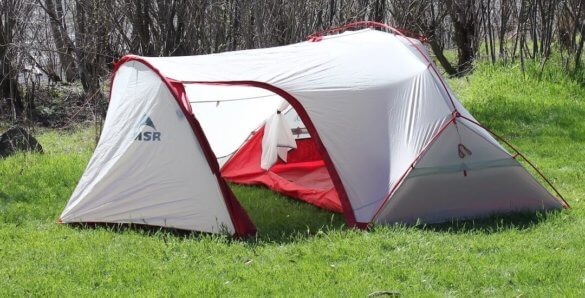
While the MSR Hubba Tour 2 Tent is relatively lightweight, hardcore backpackers might scoff at the weight, which is about 4 lbs 14 oz for the trail weight in the 2-person Hubba Tour. To put this in perspective, this is the approximate trail weight of a standard entry-level-to-midrange backpacking tent. Lots of backpackers take 4-plus pound tents backpacking because they’re affordable, durable, free-standing and easy to use — but the Hubba Tour 2 does it with a massive vestibule.
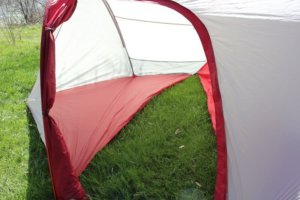
When the weather is great, we hardly think about vestibules, but what happens when the weather turns bad for a couple of days in a row? Suddenly the vestibule coverage area takes on a whole new meaning.
The point is, the MSR Hubba Tour could work well for backpackers with a dog or for extended trips where a bit more protection from the elements would be handy for gear storage — or even letting your socks or shorts dry without stringing it all up inside your sleeping area. You could use an ultralight tarp with or without trekking poles, of course, but adventure touring when you’re covering vast distances means you might need to choose a campsite without trees — and you certainly don’t need trekking poles if you’re on a bike.
MSR Hubba Tour Tent Review: Made for Roads, Trails and Waterways
MSR says the Hubba Tour is designed directly for the growing adventure touring community. It’s built for bikepackers or cycle tourers riding ultra, backroads, fat bikes or expedition bikes, as well as canoeing tourers and cross-country tourers who cover roads, trails and waterways for weeks at a time. Obviously these are great uses for the MSR Hubba Tour lineup, but it’s also light enough for the occasional backpacking trip and durable enough for the occasional car camping trip: I’m not saying it’s the best backpacking tent or the best camping tent, but it does have a versatile cross-purpose design.
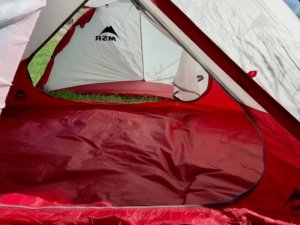
The best two features of the Hubba Tour is the exoskeleton pole system that lets you pitch the tent in the rain without getting the interior wet — and, of course, the gear-covering vestibule.
Speaking of this vestibule, touring adventurers often spend weeks away from most people but occasionally they cross paths with more populated, shared camping areas . . . sometimes you want to tuck your gear out of sight when you leave the immediate vicinity of your tent, and the vestibule gives you plenty of space for this.
MSR Hubba Tour Tent Review: Design and Setup
The primary tent pole system is all shock-corded together. This means you pull it out and start fitting the high-quality ultralight aluminum poles together to form the basic shape — and you can’t get it wrong. Each corner of the sleeping area of the tent has a grommet for the end of a leg pole, and the main pole arcs over the top. Next, you clip the tent onto the poles, raising the tent and giving it volume. The Hubba Tour does not have a traditionally separate rain fly, but the main sleeping area has its own ceiling body, which has a DWR coating. It hangs down through removable support connections from the rain fly.
The vestibule requires a separate-but-simple pole system that creates a half-circle. This vestibule material is connected to the main sleeping area of the tent and the half-circle pole system gives the end of the vestibule shape. In order to keep it standing upright, you do have to stake it down. So, technically, this isn’t exactly freestanding but it’s darn close.
There is a large door to the vestibule and then another door to enter the main tent. The other side of the tent includes its own door and small vestibule so you can enter and exit the tent from either side. This is great for calls of nature in the middle of the night — and it’s great if your vestibule turns into a full-on gear garage.
MSR includes two vents, which will help with air flow during bad weather or hot weather. Either way, you’ll likely want to prop these vents fully open. For additional air flow and ventilation, you can open the two exterior doors all the way, leave them partially unzipped or just partially unzipped near the tops. This will give you cross-breeze ventilation and help moisture escape — the two doors to the main body of the tent have triangular mesh vents, too.
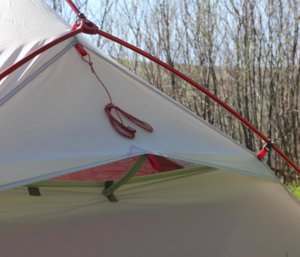
One thing I did notice when I pitched this tent is that while it’s mostly freestanding, you’ll want to do a good job of staking out the tent to ensure that it’s all taught. If you don’t stake it with the guy lines and pull them taught, the venting system won’t work nearly as well if parts of the fly sag and hinder air flow. Plus, if there’s a bit more tension on the exterior portion of the tent, it’ll do a better job of keeping gap between it and the inner main tent area. Again, the primarily benefit of this will help maximize the air flow and venting. If you can, pitch one of the vents directly into the dominant wind direction.
Personally, I would like to see a bit more mesh on the interior doors — I’d even take a slight weight hit to have fully meshed doors that could also zip closed and remain mostly waterproof.
MSR Hubba Tour Tent: Plenty of Pockets and Gear Loops
Part of the value of the Hubba Tour 2 Tent is in the gear storage thought that went into the design. You get a couple of loops for hanging light gear in the vestibule, as well as a partial groundsheet to keep your gear off the ground. There are several mesh pockets inside the tent, which will let you store your smartphone, headlamps and odds and ends.
The main sleeping area of the Hubba Tour 2 is 88″ x 52″ . . . and it’s a full rectangle. A lot of two-person tents taper together at the feet, and since I like foot room, sticking with a real rectangle is nice. In addition, if you like to use a wider lightweight sleeping pad, two such pads will easily fit side-by-side in the Hubba Tour 2.
MSR Hubba Tour Tents: MSR’s New Coating
The Hubba Tour series of tents use an MSR-exclusive “Xtreme Shield” waterproofing coating on the breathable 20D rainfly and 30D floor. MSR says this coating is more durable and will last three times longer than standard coatings.

Will this coating truly last longer than other waterproofing systems? Hard to say, but MSR seems pretty proud of its Xtreme Shield . . . and in my experience, MSR hasn’t been the kind of company that has had trouble with hyperbole — all of MSR’s gear is usually excellent and durable.
All-in-all, the MSR Hubba Tour 2 is the sort of tent that makes you want to start planning an epic ride or combo trip — whatever the weather. If you get thoroughly soaked on a ride, you can set up the tent and remove your wet clothes under the cover of the vestibule without introducing a bunch of water to your sleeping area. You even have room for motorcycle boots, helmets, jackets and pants. The overall construction is durable. Everything fits together exactly as it should. It’s easy to pitch and easy to tighten through the built-in straps and guylines. Fit and finish is impeccable. For the right kind of adventurer who can really use a roomy vestibule, the MSR Hubba Tour could be the perfect new hybrid tent. Highly recommended.
Get the Gear:
MSR Hubba Tour 1
Check shipping/pricing: Amazon | AvidMax | CampSaver | Moosejaw
MSR Hubba Tour 2
Check shipping/pricing: Amazon | AvidMax | CampSaver | EMS | Moosejaw
MSR Hubba Tour 3
Check shipping/pricing: Amazon | CampSaver | Moosejaw
One note: If you already have an MSR Hubba or Elixir backpacking tent, MSR offers an add-on “gear shed” that connects to the side of the Hubba or Elixir 1, 2 and 3-person Hubba and Elixir tents. Aptly called the MSR Gear Shed, it will create a 26.5-square-foot covered vestibule and add about 1 lbs 13 oz to your tent trail weight. Any downsides? Setup is not nearly as simple and you’re far more likely to get the interior of your tent wet if you have to set it up during a rainstorm, especially if you’re already cold and tired. With the 2-person Hubba Hubba NX, you’ll have a similar overall weight if you add the Gear Shed — but you’ll be quite a bit heavier with an Elixir (which is a heavier tent to start with). On the plus side, you can save about $90 by ordering the MSR Gear Shed with a Hubba Hubba NX 2 instead of the dedicated Hubba Tour 2 . . . and you’ll still get the massive vestibule option for adventure touring . . . plus end up with an MSR fan-favorite all-around backpacking tent in the Hubba Hubba NX 2. Something to think about if you lean more toward backpacking but still want plenty of gear space.

